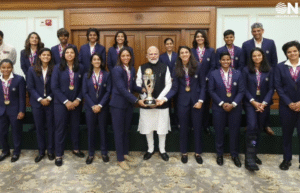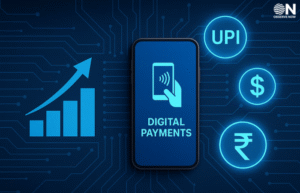In a recent webinar organized by ObserveNow media and presented by Learning Spiral, titled “Digital Evaluation in Higher Education: A Necessity for NEP Implementation?” a panel of esteemed educators and administrators discussed the imperative need for integrating digital evaluation methods into higher education systems, particularly in light of the New Education Policy (NEP) and the challenges posed by the COVID-19 pandemic. The session, expertly moderated by Manish Mohta, Managing Director of Learning Spiral, explored various facets of digital assessment, its implications for teaching and learning, and its alignment with evolving educational paradigms.
The webinar brought together a diverse panel of thought leaders from prominent educational institutions across India such as Dr. Akila Muthuramalingam, CEO, KSR Educational Institutions, Tamil Nadu; Prof. Dharam Buddhi, Vice Chancellor, Uttaranchal University, Dehradun; Dr. Abhishek Tripathi, Vice-Chancellor, C T University, Ludhiana; Dr. Pradeep Sharma, Registrar and Provost, UEM Jaipur (IEM-UEM GROUP); Dr. Indranil Bose, Vice President – Academics, Adamas University, Kolkata; Dr. N. Shani, Principal, St. Johns College of Humanities and Sciences, Palghar, Mumbai; Dr. Vaibhav Shrivastava, Pro Vice-Chancellor (Pro President), SKD University, Rajasthan; Dr. N K Sinha, Vice-Chancellor, Maharaja Agrasen Himalayan Garhwal University; Dr. Mahesh D. Goudar, Director, MIT Academy of Engineering, Pune and Dr. Roshan Lal Raina, Vice Chancellor, Jaipur National University, Jaipur.
During the session kickoff, Manish expressed that all universities have encountered the shift from annual to semester systems, incorporating mid-terms and multiple assessments. While embracing transformation, they also must adhere to the academic calendar’s demands.

The discussion emphasized a range of critical themes and recommendations essential for the successful integration of digital evaluation within higher education as Roshan stressed the importance of aligning digital evaluation methods with the objectives delineated in the National Education Policy (NEP) and the regulatory guidelines set forth by organizations such as the University Grants Commission (UGC) and the National Assessment and Accreditation Council (NAAC). This alignment ensures that digital assessment practices remain consistent with broader educational goals and standards.
Dr. Muthuramalingam emphasized the paradigm shift towards digital classrooms post-COVID and highlighted the widespread adoption of Learning Management Systems (LMS) across Indian universities. She advocated for leveraging Natural Language Processing (NLP) to personalize learning experiences based on student behavior analysis.
Prof. Buddhi underscored the importance of aligning the National Education Policy (NEP) and the National Assessment and Accreditation Council (NAAC) guidelines with the University Grants Commission (UGC) regulations. He emphasized the need for comprehensive and continuous evaluation methods.
The discussion highlighted the significance of embracing online examinations, particularly with the incorporation of AI-based proctoring. This approach not only enhances the integrity of examinations but also improves accessibility for students while reducing logistical complexities associated with traditional exam administration and the also experts emphasized the potential of leveraging technologies like NLP to personalize learning experiences.
Dr. Tripathi discussed the growing trend towards online exams and highlighted the successful implementation of proctored exams, citing the example of IIM Jammu. He stressed the significance of continuous assessment over end-term exams and the role of Artificial Intelligence (AI) in enhancing exam quality and integrity.
Dr. Sharma emphasized the transformative power of technology in education and advocated for its seamless integration into academic practices. He predicted the emergence of virtual classrooms and experiential learning platforms in the coming years.
Dr. Bose discussed the challenges of digital assessment in rural and suburban areas with limited digital infrastructure. He highlighted the need for educators to adapt to digital assessment methods and embrace new teaching-learning paradigms.
Dr. Shani reflected on the transition towards digital assessment in hybrid learning environments and stressed the importance of relearning new assessment methods in the digital era.
Efforts to address the digital divide were underscored, emphasizing the need to improve digital infrastructure in rural and suburban areas. This ensures equitable access to digital assessment tools, thereby promoting inclusivity and fairness in education and ethical considerations were highlighted, emphasizing the importance of fostering academic integrity among students. While technology can enhance assessment security, cultivating ethical values minimizes the reliance on strict proctoring measures, promoting a culture of trust and responsibility.
Dr. Shrivastava emphasized the standardization of digital evaluation methods and the transparency they bring to the assessment process. He highlighted the role of AI in enhancing the integrity of digital assessments.
Dr. Sinha discussed the transformative impact of the NEP and the accelerated adoption of digital education due to the COVID-19 pandemic. He emphasized the role of AI in minimizing delays in result publication and reducing dissatisfaction among stakeholders.
Dr. Goudar emphasized the inadequacy of rote memorization in addressing real-world problems and stressed the importance of evolving assessment methods. He advocated for a balanced approach integrating both digital and traditional evaluation methods to meet industry demands.
The webinar highlighted the critical role of digital evaluation in advancing higher education in India, particularly in the context of the NEP and the challenges posed by the COVID-19 pandemic. The insights shared by the panelists underscored the need for a holistic approach that combines technological innovation with pedagogical principles to ensure effective teaching, learning, and assessment practices in the digital age.











 The appointment of Nautiyal is pending approval from the shareholders at the upcoming Annual General Meeting of the bank. Banavar Anantharamaiah Prabhakar, Chairman of Ujjivan SFB, expressed his delight at Nautiyal’s approval, highlighting his extensive experience in retail banking and international markets. Prabhakar also commended the outgoing MD&CEO, Ittira Davis, for his contributions to Ujjivan SFB’s turnaround story.
The appointment of Nautiyal is pending approval from the shareholders at the upcoming Annual General Meeting of the bank. Banavar Anantharamaiah Prabhakar, Chairman of Ujjivan SFB, expressed his delight at Nautiyal’s approval, highlighting his extensive experience in retail banking and international markets. Prabhakar also commended the outgoing MD&CEO, Ittira Davis, for his contributions to Ujjivan SFB’s turnaround story.



















